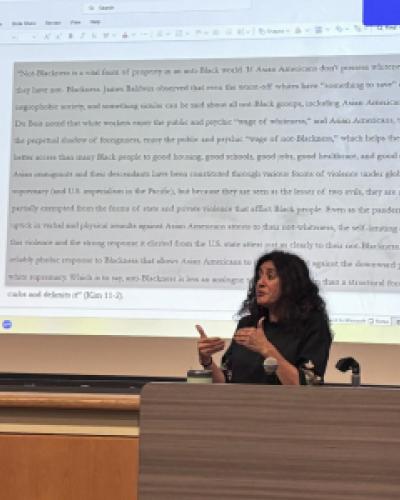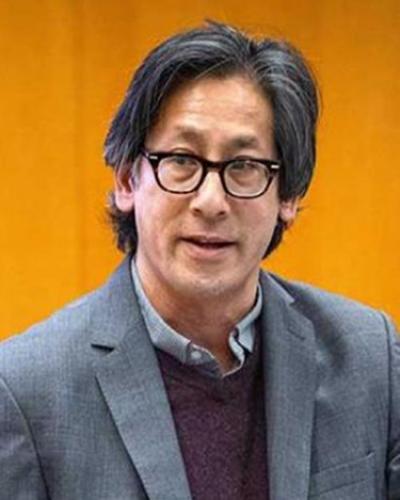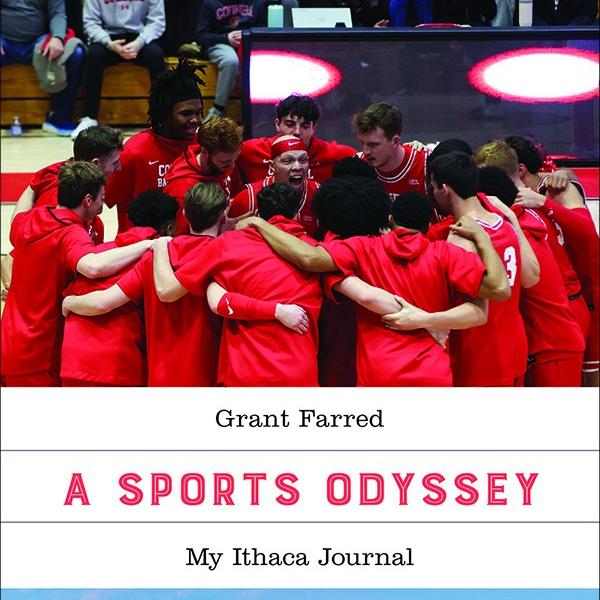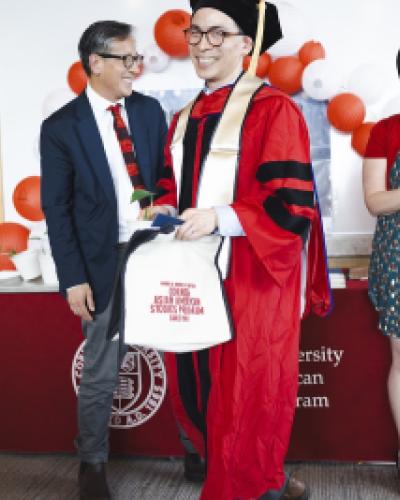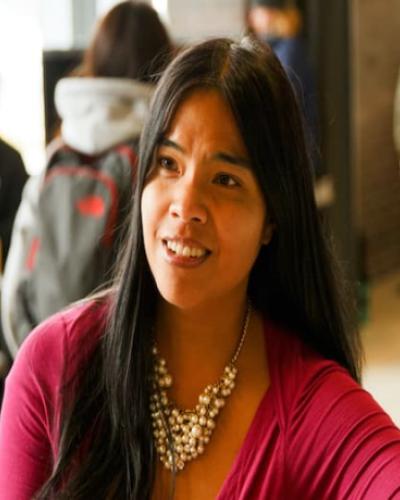Currently an Associate Professor in, and the Chair of, Ethnic Studies at the University of Colorado-Denver, Faye Caronan ‘01 returned to her alma mater of Cornell University on Thursday, April 26, 2018, to give a guest lecture titled, “Territorial Citizenship: Race, Status, and Limited Rights” for an event hosted by the Asian American Studies Program. Before the talk, a trio of AAS students — Emily Dong ‘18, Jeremiah Kim ‘19, and James Espeleta ‘20 — sat down with Professor Caronan to eat sandwiches and talk about her research, her life journey, and her memories of being an Asian American Studies minor at Cornell.
Emily: What did AASP at Cornell mean to you when you were an undergrad here? How did you decide to pursue an AAS minor?
Professor Caronan: So I was an English major, and I think Ellis Hanson was the advisor I was assigned to, and he was the one who asked me about my interests; he was the one who told me to look into Shelley [Wong]. At the time I had been reading about Philippine history, but these were Asian Studies books. So I was interested in Asian history, and I think in articulating that to Professor Hanson, he thought I would be interested in Asian American history. So he encouraged me to take Shelley’s “Asian American Literature” class — so that started it. I took her class, and shortly after I took “Intro to Asian American History” with Moon-Ho Jung, and that was that. I think that I may have, at the time, annoyed [the AAS faculty]. I wrote some questionable papers for Shelley and for Moon, where I was very much invested in the model minority myth and reproducing that, so they had to very gently say, “Okay, there is a reason why you might feel that way, but you need to explore other avenues.” So Shelley introduced me to colonialism and the US colonization of the Philippines, and Moon pushed it more. Once you realize how impactful those histories are in determining how you’ve come to where you are, you can’t put the blinders back on. Those two courses were very foundational for me. And I’ll say this at the talk later, but I was reading an article by E. San Juan Jr. here in the [Asian American Studies] Resource Center, and there were some Puerto Rican students in the next room and they were talking about US colonialism in Puerto Rico. And I was reading about US colonialism in the Philippines — at first I was like, “They gotta be quiet, I have to focus!” but then I really started hearing what they were saying. So I came to my comparative understanding of US imperialism because I was studying here at the same time that those New York Puerto Rican students were talking. If I wasn’t here, then it wouldn’t have happened. It was very serendipitous.
Emily: What year were you when you took your first AAS class?
Professor Caronan: I was a freshman when I first took Shelley’s course, and a sophomore when I took Moon’s course.
Emily: What was so compelling to you about the topic of US imperialism that you chose to spend several years of your life researching and writing a book about it?
Professor Caronan: I think the fact that it is so foundational, yet you never hear about it framed in that way. So AAS helped me to figure out “Why am I here?” beyond “My parents immigrated here for the American dream.” That is all true, but there are policies that facilitated that migration. It was US colonialism that created this idea in the US for Filipinos — these things affect where people go, how stories play out, and yet we don’t know about that beyond “My parents worked really hard, became successful, and now I find myself at an Ivy League college.” That all makes sense, but there are other historical factors that are erased when you only focus on that one dominant narrative. I felt that I needed to keep at that, because that’s why my students are here, that’s why I’m here. And then the whole comparative part of my study came from the fact that US racial categories are not porous, they’re very distinct. And I thought that we could begin to break that down — because they’re all just narratives — that we could begin to question constructions of race and build some sort of interracial understanding, or a way of understanding history differently. Not just for Puerto Ricans and Filipinos, but if you frame “refugees” not just as Southeast Asian refugees or Cuban refugees, but look at all refugees — when you focus on a theme across racial groups — you get a different kind of understanding about how US global power works.
Jeremiah: As a Korean American person, I didn’t know much about the Korean War and how that triggered the Korean diaspora. I didn’t know specifically about US imperialism and how many people died as a result of US bombing during the Korean War — that wasn’t something that was really talked about. So for you, have you had that experience of talking about your research with your parents, with your grandparents, with your relatives, etc.?
Professor Caronan: No. My dad has read my book and other things that I’ve written. He’ll say things like, “That makes sense,” or, “This is important.” But it doesn’t go beyond that. And still, for my mother, she’d rather not [read my work]. She has this idea that critiquing the US or US history is... you just don’t do that, you’re supposed to be grateful. But she’s proud of me and the fact that I’ve published a book. She was very happy that I was giving a talk here. But we don’t have those conversations. As much as AAS has helped me understand my family’s history, it doesn’t go that way.
Jeremiah: Making comparisons is one thing, and it feels like the natural step beyond comparisons is solidarity. Have you found those sort of linkages in the times and places that you were studying, and do you think there’s a possibility for that kind of solidarity?
Professor Caronan: I have not. I look at the US colonial period, and I have heard that during the Spanish colonial period, Cuban nationalists and Filipino nationalists were educated in Barcelona, so there was cross fertilization of movements there. But that changes under US colonialism because of the divergent histories that you get out of Puerto Rico and the Philippines. Cuba becomes independent, so there’s a different type of relationship between US and Cuba, as distinct from the US and Puerto Rico and the Philippines. For my book project, I looked at US Puerto Rican culture and US Filipino culture, and part of the reason why I didn’t find those kinds of solidarities is because I was doing cultural studies analysis. It wasn’t necessarily talking to people in movements. But it also has to do with those racial categories. When I look at novels by Jessica Hagedorn and Esmeralda Santiago, they’re framed for an American audience. They’re not framed as a story about US colonialism — as much as those book are about US colonialism. One of the books is framed as “Your exciting look into this gritty Manila scene” for Dogeaters, so it takes you on a touristy view of Manila. This framing erases or does not highlight the critique of colonialism in Jessica Hagedorn’s work. Whereas for Esmeralda Santiago’s work, that’s also framed for a particular audience. This is a narrative of a woman reclaiming her power. So it has this kind of feminist theme. You have these similar stories, but they’re framed for audiences in particular ways, so it’s hard to see [the connection]. And that has to do with marketing. It has to do with seeing these places as distinct so that it becomes hard to get at that comparative understanding, unless you go into it with the intention of getting at those understandings.
I also spoke to performance poets, and in that case there are not a lot of [coalitions]. I look at Filipino poets in Los Angeles and Puerto Rican poets in New York. There aren’t a lot of Puerto Ricans in Los Angeles, so I didn’t find any kind of coalition-building there. In New York, there are active Filipino poet groups there like Kundiman, but I didn’t see a lot of collaboration between the Puerto Rican poets and the Filipino American poets. I went to events, but they were discrete. And just the way I designed the study, I didn’t interview a lot of Filipino poets in New York because I was looking at circuits of activism. So I was looking at the Pacific Filipino circuit, and then I was looking at the New York Puerto Rican circuit. It may have been there in New York but I didn’t see it — which doesn’t mean that it wasn’t there. The methods that I was using may not have led me to those places.
James: You mentioned how there’s a lack of solidarity between Filipino Americans and Puerto Rican Americans, so why do you think that that’s the case? Do you think it’s a case of racial lumping, where Filipinos are placed under the category of “Asian”, whereas Puerto Ricans are placed under the category of “Hispanic” or “Latino”?
Professor Caronan: I think that’s part of it, and also the locations where you have large populations of Filipinos and Puerto Ricans. I have a colleague from Florida who says that there might be shared spaces that he has found in his work. Part of it is geography — you have to have both populations in the same place in order to build those solidarities. In LA, some of the Filipino poets identified and organized a lot with Chicanos because there’s a large population of Filipinos and Mexicans, plus the longer history of Manila-Acapulco trade that came to LA. They understood that and tried to build solidarity across racial lines; they do have that understanding of a shared history and common experiences. So it’s not to say that it doesn’t happen, it just depends a lot on the location, and if you have the populations there. If you do have those circumstances existing, then those coalitions are possible. It might have happened in New York and I just didn’t see it. But it could also be that there are so many groups in New York that it might lead to coalitions within racial groups as a opposed to across.
Jeremiah: Based on what you’re saying about the need for there to be actual proximity in order for cross fertilizations, solidarities, and coalitions to occur, it seems like a college campus might be one of those sites. As a professor of Ethnic Studies at the University of Colorado-Denver, do you see those kinds of solidarities happening? And do you also work to facilitate that in your teaching and how you interact with students within and beyond classes?
Professor Caronan: I do try to facilitate that. I work with the Center for Identity and Inclusion to plan events with them. Hispanic Heritage Month is mid-September to mid-October, and Philippine History month is October, so in that overlapping time I brought over Ruby Golbara from Arizona State University who does work on Mexi-Pino communities, just to throw out there that (1) Mexicans and Filipinos have this longer history together, and (2) to also have people think, “If our racial categories are so rigid, what about mixed race folks?” So I try to facilitate it that way, and then when I teach “Intro to Asian American History,” I always bring up historical junctures: “This is how [this event] relates to what’s happening with Native Americans, African Americans, and Latinos at the time.”
I would say that my campus is mainly a commuter campus, so we have a high population of first-gen folks and non-traditional students. They’re just holding down jobs, they have family responsibilities, and they’re going to school full-time. Because of that, it makes it difficult. There is organizing on campus right now, especially for our undocumented students, but they’re just very busy people. Under those circumstances, it’s difficult to sustain those kinds of coalitions. With the undocumented students, there has been a concerted effort to realize that even though we think of this as primarily a problem for Mexican American students, there are also Asian students who are undocumented. So I do have a student right now who is going to start a research project on Asian undocumented students, but in terms of organizing on campus, it’s a tricky thing. They’re so busy.
Jeremiah: If someone who had never heard of AAS were to ask you, “What is Asian American Studies and why is it important?” what would you say?
Professor Caronan: I’d probably respond in the same way that I talked about it before. Asian American Studies and Ethnic Studies are important simply because knowledge production to this point has a very specific perspective, and we see that perspective as a universal one, when it’s not. Most people will think that Ethnic Studies is its own separate discipline, and if you think about it in the usual way of multicultural inclusion, it’s a matter of “You learn something and it’s just this other thing that doesn’t change anything else.” But Ethnic Studies is supposed to be transformative. Asian American Studies is supposed to be transformative. You learn Asian American history and it transforms US history. But that is where it gets stuck: you learn it, and it doesn’t trickle into other things. There’s this disconnect. And there are various reasons for that disconnect. Mainly, you don’t have Ethnic Studies everywhere. But that’s why it’s important. For my students, and when I was a student, it’s important because otherwise you don’t understand yourself in any kind of deep way. You only understand yourself in these general narratives of, “I’m an immigrant, my parents came here for a better life.” And that is true, but there is all this in the background that should transform not just history, but all these other disciplines. So that’s why it’s important, and why I continue to teach it. I’m in an Ethnic Studies department in an institution that doesn’t value Ethnic Studies. We don’t get much funding. I’m the chair now, and I’m trying to create things like an Asian American Studies certificate. We got a Native American Studies certificate through. How can we bring these students in to teach them this knowledge? Not just to say, “Oh, now I know something about everyone!” It’s supposed to be transformative.
Jeremiah: If you give one piece of advice to students here at Cornell, but especially students who are searching for what it means to be “Asian American” or simply responsible human being, what would you say?
Professor Caronan: I felt like I had a lot of privilege here. I had a lot of time to sit and think about things and develop ideas that I don’t think my students [at University of Colorado-Denver] have the time to do. So for students here, I would say to take advantage of that: the ability to just think. Well, first of all, take Asian American Studies and Latino Studies courses! If you’re a student of color, that’s the way you’re going to understand how you fit into US history or into the United States. Take that time to think things through. In the years since I’ve been here, it seems like I have less and less free time. I became a grad student, and I still had a lot of time to sit and think, but it was still less time than I had here. And then I became a faculty member, and I had teaching, research (which you barely ever have time for), and then service. There’s not a lot of time. I took for granted a lot of time where I could read what I wanted to read, research what I wanted to research. I think about the fact that I was privileged enough, that I wasn’t working a full time job — being a student was my full time job — that I had a lot of time to just reflect. It was important for me to figure out the history of US colonialism in these two spaces, and I had the luxury of time to look into that. And I had Shelley Wong and Mary Pat Brady [in Latino/a Studies] as excellent mentors, who made the time to help me think through that. Take advantage of the things that you get as a student in a place like this, that students in other places might not have. You shouldn’t just be wasting your time with other things, but instead using your time to really think.
James: Going back to the idea of Filipino Americans being marginalized within the category of “Asian American”, do you have any advice about how to get out of that marginalization?
Professor Caronan: In certain ways, Filipino Americans are marginalized within the “Asian American” category. But I think there are opportunities within that category as well. So if you center imperialism, you have those conversations with militarization in Japan in World War Two, in Korea during the Korean War, in Vietnam, there are a lot of ways you can reframe and refocus what, for the mainstream, is the model minority narrative. But if you look critically at Asian American Studies and the Asian American category, there are a lot of ways that Filipino Americans fit within that category beyond geography. A lot of the Asian American population in the US is here because of the history of US militarism in Asia and the Pacific. I would say that in order to make meaningful interethnic coalitions, you need to reframe certain issues for organizing purposes. But in reframing those issues it also opens up other conversations — if you’re talking about US militarism, there have been international movements of Puerto Rican women and Japanese women around what happens near US military bases. That’s an international, interracial movement that centers around a specific issue. If you reframe the “Asian American” category and Asian American Studies in different ways, you’ll have these meaningful connections that’ll actually make Filipinos more central to Asian American Studies.

